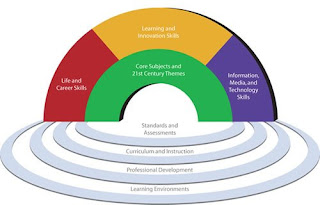It is quite similar to the last Horizon Report but consists also of new stuff like e.g. "geo-everything". In the first adoption horizon we find mobiles and cloud computing, both of which are already well established on many campuses — and still more organizations have plans in place to make use of these technologies in the coming months. Institutions at the leading edge of technology adoption are also already applying the two clusters of technologies we have placed on the mid-term horizon, geo-everything and the personal web. All four topics on the first two horizons are already in common use in other sectors, including entertainment, commerce, and the world of work. The two technologies placed on the far-term horizon, semantic-aware applications and smart objects, are not yet commonly found in an educational context, although research is being conducted in both areas and the rate of development seems to indicate that these topics are well worth watching.
Each profiled technology is described in detail in the body of the report, including a discussion of what it is and why it is relevant to teaching, learning, research, and creative expression. Specific examples are listed there for each of the six topics
- Mobiles: New interfaces, the ability to run third-party applications, and location-awareness have all come to the mobile device in the past year, making it an ever more versatile tool that can be easily adapted to a host of tasks for learning, productivity, and social networking.
- I would like to add: These developments make it even more difficult to gather these emerging tools and conclude its potential for teaching and learning. - Cloud-Computing: The emergence of large-scale “data farms” — large clusters of networked servers — is bringing huge quantities of processing power and storage capacity within easy reach. Inexpensive, simple solutions to offsite storage, multi-user application scaling, hosting, and multi-processor computing are opening the door to wholly different ways of thinking about computers, software, and files.
- How many/ Which universities are using Grids? Regarding Germany I only know of Trier, Göttingen, Mannheim and Würzburg. - Geo-Everything: Many common devices can automatically now determine and record their own precise location and can save that data along with captured media (like photographs) or can transmit it to web-based applications for a host of uses. The full implications of geo-tagging are still unfolding, but the impact in research has already been profound.
- More details are to find in the body of the report :) - The Personal Web: Springing from the desire to reorganize online content rather than simply viewing it, the personal web is part of a trend that has been fueled by tools to aggregate the flow of content in customizable ways and expanded by an increasing collection of widgets that manage online content. Using a growing set of free and simple tools and applications, it is easy to create a customized, personal web-based environment — a personal web — that explicitly supports one’s social, professional, learning, and other activities. - Services such as Bookmarking, commenting and suggestion of similar media are also possible in a catalog: to offer a so-called OPAC2.0 is a goal.
- Semantic-Aware-Applications: New applications
are emerging that are bringing the promise of the semantic web into practice without the need to add additional layers of tags, identifiers, or other top-down methods of defining context. Tools that can simply gather the context in which information is couched, and that use that context to extract embedded meaning are providing rich new ways of finding and aggregating content. At the same time, other tools are allowing context to be easily modified, shaped, and redefined as information flows are combined. - Which services are examples that are already in successful practice? What is possible in the environment of library and further learning environments? - Smart Objects: Sometimes described as the “Internet of things,” smart objects describe a set of technologies that is imbuing ordinary objects with the ability to recognize their physical location and respond appropriately, or to connect with other objects or information. A smart object “knows” something about itself — where and how it was made, what it is for, where it should be, or who owns it, for example — and something about its environment. While the underlying technologies that make this possible — RFID, QR codes, smartcards, touch and motion sensors, and the like — are not new, we are now seeing new forms of sensors, identifiers, and applications with a much more generalizable set of functionalities.
Moreover the Horizon Report 2009 offers further information about several other developments which cannot be described with one specific buzzword:
Visualization tools are making information more meaningful and insights more intuitive. As tools of this nature continue to be developed and used, visual literacy will become an increasingly important skill in decoding, encoding, and determining credibility and authenticity of data.
Students are different, but a lot of educational material is not. Schools are still using materials developed decades ago, but today’s students come to school with very different experiences than those of 20 or 30 years ago, and think and work very differently as well. Institutions need to adapt to current student needs and identify new learning models that are engaging to younger generations.
Significant shifts are taking place in the ways scholarship and research are conducted, and there is a need for innovation and leadership at all levels of the academy. A challenge cited as critical now for several years running, academic review and faculty rewards are out of sync with the practice of scholarship. Clear approaches to assessing emerging forms of scholarly practice are needed for tenure and promotion. Students who are living and learning with technologies that generate dynamic forms of content may find the current formalism and structure of scholarship
and research to be static and “dead” as a way of collecting, analyzing and sharing results.








